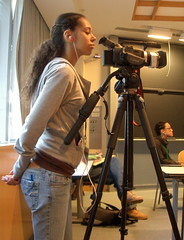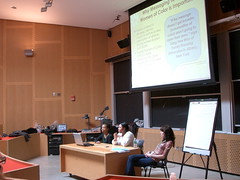WAM! It's more than just onomatopoeia...it's women media
Categories:
 I'm here at MIT (my fall place of graduate Urban Planning studies, btw) at the 2007 Women Action and Media (WAM!) conference this weekend, a yearly conference that combines a bunch of topics that interest me - media, activism, social justice, and women's issues. I read BITCHfest for my book club recently (selections from BITCH magazine), and it got me more interested in feminist media related issues, especially in that the techniques and lessons learned by feminist activists around framing in the media relates to many other issues (such as poverty, network neutrality, and more).
I'm here at MIT (my fall place of graduate Urban Planning studies, btw) at the 2007 Women Action and Media (WAM!) conference this weekend, a yearly conference that combines a bunch of topics that interest me - media, activism, social justice, and women's issues. I read BITCHfest for my book club recently (selections from BITCH magazine), and it got me more interested in feminist media related issues, especially in that the techniques and lessons learned by feminist activists around framing in the media relates to many other issues (such as poverty, network neutrality, and more).
So far, I've gone to three very different sessions. The first pre-conference session attracted me around the idea of framing class more effectively in the media. [I mean, come on, we're VISTAs fighting poverty, right?] Ellen Bravo (and her book, Taking on the Big Boys) suggested a few interesting hooks to change the way the mainstream media frames issues of class and work:
The Snow Day - The kids don't have to go to school, but many low-income parents do; that means that a snow day really means a day home alone for many youth.
The Flu Epidemic - The media is always covering stories about people not staying home to stop the spread of the flu virus. But if you really think about it, people with low paying and/or part-time jobs can't afford to take sick days and they usually have service jobs like cleaning public spaces or handling food.
"Best places to work" lists - We need to probe more about these lists, because the companies on the list often give money to associations that give awards.
I went from thinking about poverty's media image, to the image of social change on the web. Allison Fine, and her book Momentum: Igniting Social Change in the Connected Age, has been getting a bit of buzz at Project HQ because it's basically what the CTC VISTA Project is trying to do only a daily VISTA basis. Mostly the session fueled more questions than answers:
- ? Is MoveOn.org really just a reflection class organizing techniques?
We need to tap into the core fundamental ways of behaving by successful social change organizations and how they convey to using new media/tech. Primarily, we should focus on how to start and facilitate conversations to build a movement. You can start with an online conversation but they can be better implemented combined with in-person discussions. - ? Why are there no comments on our organizations blog?
There was a frustration around not getting any interactions on blogs and listservs, because they get put out there and they don't get used. This can be combatted through connecting these conversations to in-person interactions and by also participating in other nonprofit's online networks. - ? Are we blogging/podcasting just because it's cool?
The challenge is that there is an array of tools to have two-way interactions but are non-profits really taking advantage of that? Are they really offering up space to comment, but they don't respond (listening deficits)...behaving still one-to-many communication scheme? - ? Are we liable for things said in blogs/forums on a site if we host it on our server? Many participants were afraid of not having enough control of the message if the movement building happens in an online social network.
 On Saturday, I became "press", helping Alana, a very capable young woman of the Project Think Different Media Watch Team, video several sessions over the course of the day.
On Saturday, I became "press", helping Alana, a very capable young woman of the Project Think Different Media Watch Team, video several sessions over the course of the day.
In the Our 21st Century Bodies, Our Multimedia Selves session, the presenters spoke about how their transporting information dissemination from a published book (Our Bodies, Our Selves) to online (http://www.ourbodiesourselves.org). I liked how Elana Hayasaka simplified how new online media are taking advantage of the weaknesses of classic print media for activism:
- update quicker and more often
- more accessibility / web search function
- avoid cost page limits
- dispersal to a wider audience
- involve the reader (interactivity)
- appeal to younger readership
Yet again, the topic of the "freedom" of blogging versus having a moderation scheme came up. But I like that they admit that the focus of the blogs shouldn't just be just a public relations tool for the organization, but instead give a framework (social, political) for further discussions of women's health. I also really like one example blog they referenced Hollaback Blogs, that encourages people to blog a photo/video (from your camera phone) of a person that sexually harass them on the street.
 "For some fun, go listen to the HOTGirls (Helping Our Teen Girl in Real Life Situations) version of JT's "Sexy Back." It's a good way to start thinking about framing media for young women of color (YWOC), as demonstrated by this project out of Atlanta, GA. I was really impressed by the materials from the presenters in this workshop, from the Advocacy Institute - they have some great handouts on Designing Effective Outreach Strategies. More so, I was impressed by the media examples from the Pro-Choice Public Education Project (PEP) Recognize campaign. Most interestingly, both HOTGirls and PEP have campaigns/programs fueled by youth leadership councils and did extensive research ahead of time on tailoring the message effectively for YWOC.
"For some fun, go listen to the HOTGirls (Helping Our Teen Girl in Real Life Situations) version of JT's "Sexy Back." It's a good way to start thinking about framing media for young women of color (YWOC), as demonstrated by this project out of Atlanta, GA. I was really impressed by the materials from the presenters in this workshop, from the Advocacy Institute - they have some great handouts on Designing Effective Outreach Strategies. More so, I was impressed by the media examples from the Pro-Choice Public Education Project (PEP) Recognize campaign. Most interestingly, both HOTGirls and PEP have campaigns/programs fueled by youth leadership councils and did extensive research ahead of time on tailoring the message effectively for YWOC.
 [Download the powerpoint from the Do You Know Who You’re Talking To?: Effective Messaging for Young Women of Color, with Nicole Clark, Candace Webb session here.]
[Download the powerpoint from the Do You Know Who You’re Talking To?: Effective Messaging for Young Women of Color, with Nicole Clark, Candace Webb session here.]
Finally, I ended the day in the "On the front-lines of Media Justice: Transitions in Policy and Movement Building" - which really meant: how do we change gears in a social change organization without causing a crash. Hannah Sassman presented a great case study of how Prometheus Radio Project decided if they were going to expand their community radio efforts into community wireless efforts. They made the hard decision to not go with the community wireless buzz because it didn't fully serve their constituents.
"We made the decision to put off expanding into wireless advocacy efforts until when the time was right, not when the time was sexy." Sari Gelzer also alluded to the decision making process of the Global Action Project to update their efforts to train youth-led organizations in media skills, in an environment where the part-time implementors of programs in non-profits didn't necessarily have time and/or opportunity to participate in decision-making.
[We had a great discussion on some specific examples of how non-profits approach transitions and sustainability, but I had videotape the session so I'm hoping Hannah posts the notes soon on her blog http://hannahjs.worpress.com.]
On that note, I'm pooped. I'm off.











